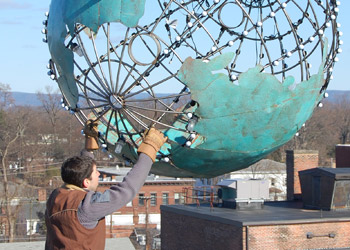Over a decade ago, when Sam Ostroff first dropped out of Hampshire College and set up his metal shop in the abandoned Ferry Street warehouses in Easthampton, there were those among his friends who doubted whether he knew what he was doing.
“Some of my early work was a bit out there,” he admitted in a recent interview. “I guess you couldn’t say it was very practical.”
One of the first works of sculpture he produced was the size and shape of a grand piano, but instead of music, it produced gasps. Inside the stainless steel frame, the guts of the piano were part mechanical and part organic—gears and crankshafts intermingled with metal rods twisted and curving through the piece like vines. His sculpture had a keyboard, but just above it, in the center of the piece, was a huge, ancient dial. It had once measured the pressure inside some industrial-sized container, but here it was flanked by two massive horns taken from the head of some monster steer.
He called the piece, which must have weighed a ton, Sonata No. 1, and said it represented the classical piano music he loved frozen in time. Rachmaninoff. Glenn Gould’s Goldberg Variations. It truly evoked awe, but who had room for it or a floor strong enough to support it?
His work was utterly cool, but at first glance, Ostroff was not. While he could rattle off the names of composers and virtuosos he listened to, the lad was clueless about huge swaths of current popular culture. He had no idea who the Talking Heads were and only a foggy grasp of some of the songs the Stones might have played.
He was built like a jock and had dashing good looks, but there was something geeky about him, too. For fun, he built elaborate electric chairs and strange chess tables that looked like they’d get Tim Burton all giddy. Ostroff liked and bought nicely designed machines and tools from yesteryear to pound and twist his art, and he filled his shop to overflowing with interesting scraps of salvaged metal.
Interesting? No doubt. Sound business strategy that would result in a lucrative career? Reply hazy, please try again.
People were enchanted with what he presented at shows like the Paradise City Arts Festival, but he didn’t sell anything. He was given a scholarship by the festival’s promoters, who saw him as an up-and-coming artist, but not much had happened in his career by the following year when someone new was awarded the title.
There were rumors that a Hollywood studio wanted to use his work in a movie, but that fizzled. A pornography photographer asked to use his shop as a setting for an S&M shoot. It just wasn’t clear where Ostroff’s seriously heavy and incredibly cumbersome art was going to fit in and be taken seriously.
His work simply begged the question: who was going to ever buy this guy’s stuff and where could he ever display it?
As it turns out, the answer is that lots of people would start buying it, and it would begin appearing all over Ostroff’s adopted home town, Northampton.
He began making signs to pay the bills while he made art, and early on he got a number of jobs from Boston-based architects that helped keep him in business. But as he began working on signs and other interior elements for architects—such as staircases, railings and fireplaces—Ostroff learned to make his unique visual style and metal skills work well with other styles and visions.
His signs adorn many handsome and impressive edifices in town, and it’s clear that he’s also learned to adapt his style to enhance a variety of historic architectural styles. The curls in the Hempest or Lucky’s signs on Main Street work well with the structural adornments at the top of those buildings, whereas the simple, vertical boldness of his signs for Eastworks in Easthampton or the Nonotuck Mill in Florence enhance those qualities in the buildings themselves.
As Ostroff says of the mill signs, “[They’re] not the most creative signs, but simple and bold was what the projects called for. I do love stainless steel on brick—the best of new and old.”
Few question Ostroff’s abilities now. Along with an employee and a much bigger studio at the Arts and Industry building in Florence, he also has a home down the street where he lives with his wife and baby boy. On some nights, you can even hear them dancing the night away to “Jumping Jack Flash.”



